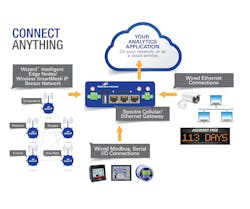Internet of Things Drives B+B Electronics' Rebranding as B+B SmartWorx
In the first Internet of Things-related rebranding I have encountered in the industrial automation sector, B+B Electronics announced today that it is rebranding itself as B+B SmartWorx.
Mike Fahrion, director of Internet of Things (IoT) and edge intelligence product development at B+B SmartWorx, says that this rebranding marks the emergence of a “different company with new technologies and a new approach, but not a different business model” as the company will remain focused on providing industrial networking hardware.
The new technologies Fahrion refers to are the Wzzard Intelligent Sensing Platform (released in fall 2014) for creating wireless sensor networks where customer applications and logic reside at the network edge, and the Swarm intelligence-based cellular edge gateway devices. The Swarm gateway devices are the next generation of B+B’s Spectre gateways and are planned for release in summer 2015.
These two technologies will combine to form the B+B SmartWorx IoT Edge Processing Architecture, says Fahrion. “By addressing the problems of interoperation and semantics, pushing intelligence out to edge devices and organizing communications on an event-driven basis, we are able to construct architectures which provide capabilities beyond those of siloed machine-to-machine systems,” he says.
Fahrion adds that even the best modern edge devices “only address the needs of data aggregation and filtering within the device itself. To realize the full potential of the Internet of Things it will be necessary for edge devices to communicate with each other without dependencies on higher layers within the architecture to distribute intelligence and resources. This is why we’re developing an edge gateway platform that introduces the concept of swarm intelligence. It is the notion that a collective of physical devices, each relatively simple in it’s own right, can be operated as a single swarm device and be almost infinitely expandable—both in terms of physical interfaces as well as in terms of processing and memory resources.”
An interesting development Fahrion has noted around industrial IoT projects relates to the kinds of calls the company has been getting lately. “B+B has been selling wireless I/O for more than a decade and we’ve never received a sensor compatibility question until the release of Wzzard last fall,” he says. Fahrion points out that such questions come from the IT side of the manufacturing business, which is largely unfamiliar with industrial sensor technology. Calls like these, Fahrion says, are often connected to industry IoT initiatives. He adds that these initiatives are leading to a breakdown of the walls that have historically separated IT and OT (operations technology).
The newly rebranded B+B SmartWorx is clearly positioning its edge processing technology as a bridge between the IT and OT gap. Fahrion explains that the company’s focus with Wzzard and Swarm is to aggregate data from existing equipment, translate disparate machine protocols into a language IT can understand, transform that data into useful information, and deliver it to applications for analysis.
A key driver behind the expanded technology focus of the B+B SmartWorx rebranding is B+B’s 2012 acquisition of Conel, a Czech Republic-based supplier of industrial cellular gateways. “The Conel acquisition gave us an immediate pedigree within Europe, and our new technologies build upon this trusted base,” says Jerry O’Gorman, CEO of B+B SmartWorx. “With the integration process complete, it seems right to combine our identity into a single brand, bringing together the best of what has been achieved in Europe and the U.S. over the past decades, and signaling our strategic direction for the future.”
The new focus on intelligence at the edge of the network has also led B+B to invest in software engineering expertise at all of its global locations, including a new team in Galway, Ireland. “Historically, B+B averaged one or two software engineers for every hardware engineer; today it’s six or eight to one,” says Fahrion.

